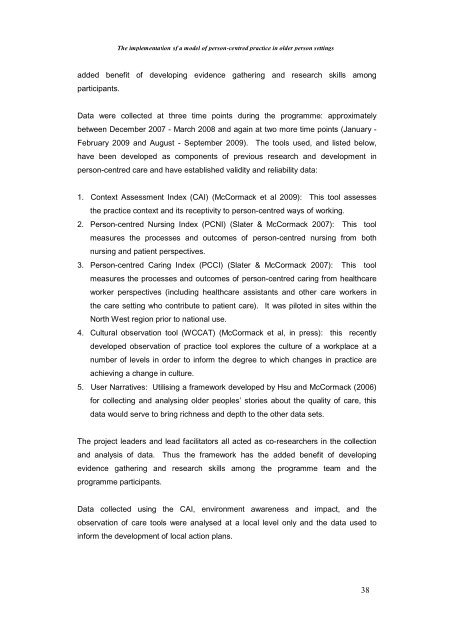The Implementation of a Model of Person-Centred Practice In Older ...
The Implementation of a Model of Person-Centred Practice In Older ...
The Implementation of a Model of Person-Centred Practice In Older ...
Create successful ePaper yourself
Turn your PDF publications into a flip-book with our unique Google optimized e-Paper software.
<strong>The</strong> implementation <strong>of</strong> a model <strong>of</strong> person-centred practice in older person settings<br />
added benefit <strong>of</strong> developing evidence gathering and research skills among<br />
participants.<br />
Data were collected at three time points during the programme: approximately<br />
between December 2007 - March 2008 and again at two more time points (January -<br />
February 2009 and August - September 2009). <strong>The</strong> tools used, and listed below,<br />
have been developed as components <strong>of</strong> previous research and development in<br />
person-centred care and have established validity and reliability data:<br />
1. Context Assessment <strong>In</strong>dex (CAI) (McCormack et al 2009): This tool assesses<br />
the practice context and its receptivity to person-centred ways <strong>of</strong> working.<br />
2. <strong>Person</strong>-centred Nursing <strong>In</strong>dex (PCNI) (Slater & McCormack 2007): This tool<br />
measures the processes and outcomes <strong>of</strong> person-centred nursing from both<br />
nursing and patient perspectives.<br />
3. <strong>Person</strong>-centred Caring <strong>In</strong>dex (PCCI) (Slater & McCormack 2007): This tool<br />
measures the processes and outcomes <strong>of</strong> person-centred caring from healthcare<br />
worker perspectives (including healthcare assistants and other care workers in<br />
the care setting who contribute to patient care). It was piloted in sites within the<br />
North West region prior to national use.<br />
4. Cultural observation tool (WCCAT) (McCormack et al, in press): this recently<br />
developed observation <strong>of</strong> practice tool explores the culture <strong>of</strong> a workplace at a<br />
number <strong>of</strong> levels in order to inform the degree to which changes in practice are<br />
achieving a change in culture.<br />
5. User Narratives: Utilising a framework developed by Hsu and McCormack (2006)<br />
for collecting and analysing older peoples’ stories about the quality <strong>of</strong> care, this<br />
data would serve to bring richness and depth to the other data sets.<br />
<strong>The</strong> project leaders and lead facilitators all acted as co-researchers in the collection<br />
and analysis <strong>of</strong> data. Thus the framework has the added benefit <strong>of</strong> developing<br />
evidence gathering and research skills among the programme team and the<br />
programme participants.<br />
Data collected using the CAI, environment awareness and impact, and the<br />
observation <strong>of</strong> care tools were analysed at a local level only and the data used to<br />
inform the development <strong>of</strong> local action plans.<br />
38
















